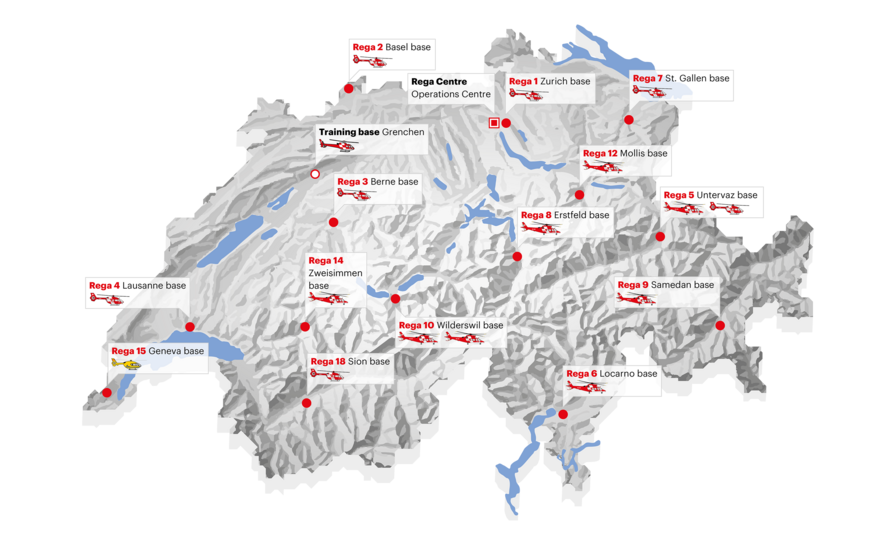Rega’s helicopter bases are distributed throughout the country in such a way that the rescue crews can reach any location in Switzerland within 15 minutes’ flying time. Rega’s founder, Dr Rudolf Bucher, already laid the foundation stone for this operational model back in the early 1950s. In his book, “Fliegen Retten Helfen”, he states: “However quickly our aircraft may be ready for takeoff, however quickly they may be able to cover relatively long distances, (…) right from the beginning, we do not want to start out on our missions from a single, central point of departure”.
More flexibility thanks to countrywide distribution
The distribution of the air rescue resources at various, decentral locations not only allows short approach paths, but also provides more flexibility in the choice of helicopter: if the crew from one base is unable to take off due to dense fog, another base that is not surrounded by fog can take over the mission. Since the very beginning, the choice of locations for Rega’s bases has not been governed by cantonal borders or political interests, but rather by factors that are of key importance for air rescue, such as the topography. One such example is the Engadin: when there is low-lying cloud, the 80-kilometre long, high-lying valley in south-east Switzerland cannot be reached by a helicopter stationed outside the valley. However, as Rega wants to provide basic medical care by air around the clock in the Engadin, too, it operates a helicopter base all year round at Samedan Airport.
Central coordination is necessary
In order for Rega’s operational model with 14 helicopter bases distributed all over the country to be optimally utilised for the benefit of the patients, all the missions need to be centrally coordinated. This is the only way to ensure that the nearest suitable crew is always called out, taking into account all the ongoing missions and other relevant factors such as the weather conditions. Rega’s pioneers had already recognised this fact, too, and recorded it in the 1961 Annual Report: “A central operational coordination unit can maintain an overview of all the aircraft that are standing by or being deployed [...]. We are responsible for ensuring that the means of rescue that is most appropriate and closest to the scene of the accident is deployed” – an insight that, given the ever-increasing number of missions and the growing complexity of the field of air rescue, is more relevant today than ever before.
For it is the combination of decentralised locations and the central, overarching coordination of the rescue helicopters that ensures that in an emergency, medical assistance by air reaches the patient as quickly as possible.
For this this reason, over the past 70 years, Rega has invested not only in its bases and rescue helicopters, but also in its national air rescue coordination centre – that is, the very core of its operational concept. Here, flight coordinators specifically trained to deal with the requirements posed by air rescue organise all the helicopter missions. They not only mobilise the nearest suitable crew, but also support them throughout the missions and constantly coordinate with mission partners, such as the police, ambulance service, piste rescue services, hospitals, mountain rescuers and private individuals, as well as between the helicopter crews.
Funded by patrons
With this deployment system, Switzerland has one of the densest air rescue networks in the world. The foundation for this was laid by the Rega pioneers with their analyses and deliberations. However, it was others who financed the costly infrastructure: to this day, the patrons fund the infrastructure with their solidarity contributions. They enable us to continually expand this network for the benefit of the Swiss population and thus further improve the provision of medical care by air.
Additional rescue helicopters if neededWe know from experience that on beautiful winter weekends or during the school holidays, for example, we should expect a higher number of missions. On such occasions, additional rescue helicopters are stationed at the Rega bases in Wilderswil und Untervaz. They operate as Rega 16 (Untervaz) and Rega 17 (Wilderswil) and ensure that even on very busy days, casualties swiftly receive emergency medical assistance by air. |
